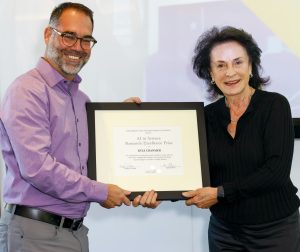Kyle Cranmer, professor of physics and director of the Data Science Institute at UW–Madison, has been honored with the inaugural Pritzker Prize in AI for Science for his role in establishing a powerful new approach to data analysis that leverages advances in machine learning and artificial intelligence.

Cranmer received this award on Monday at the Conference on AI+Science, hosted by Caltech and the University of Chicago, in Pasadena. The prize recognizes his contributions to and advocacy for simulation-based inference, which combines AI and computer simulations to enable statistical analysis of data in situations where it was not previously possible.
“With advances in machine learning and AI, simulation-based inference is ushering in a new era of statistical inference for many different areas of science, and I find it extremely compelling,” says Cranmer.
Simulation-based inference holds potential to transform scientific practice in diverse academic fields including particle physics, evolutionary biology, and neuroscience. To explain how it works, Cranmer uses the example of studying the site of an auto accident to try to correctly infer the cause of the crash. Data collected at the site, including physical evidence and human accounts, are often consistent with many possible scenarios instead of a unique explanation of what happened. Simulation-based inference would use AI together with simulations to estimate the probability that each scenario is what led to the accident.
“For decades, scientists have had to limit the kinds of questions they ask because we didn’t have the methodology to be able to answer them. This kind of dramatic improvement in capabilities allows us to go back to square one and start addressing the questions that we’ve wanted to ask for years.” —Kyle Cranmer
Cranmer spent the first part of his career focused on high-energy particle physics at the Large Hadron Collider at CERN, and he was part of the team that discovered the Higgs boson in July 2012. This discovery coincided with major advances in the field of deep learning, a form of AI where computer algorithms learn from examples. After the Higgs discovery, Cranmer started thinking about how to incorporate deep learning into scientific practice.
“I was grappling with a specific problem that we encounter in particle physics,” says Cranmer. “We have really good simulations of what the particle collisions look like at the Large Hadron Collider, but, ironically, it’s hard to work with those simulations when we want to statistically analyze the data. And that’s when I realized that deep learning could solve that problem, which gave rise to what we now call simulation-based inference.”
Over the past decade, Cranmer’s research has focused on simulation-based inference in physics, as well as generalizing these techniques to other areas of science. In simulation-based inference, domain scientists such as biologists, chemists, or physicists typically collaborate with methodological experts in computing, data science, and statistics. The roles of these partners are clearly defined and intellectually challenging, creating a template for collaboration that is both appealing and easily replicated in many different fields.
“One of the things that I like a lot about simulation-based inference is it has really clean responsibilities between your domain scientist and those with a more statistical, machine learning, and computer science point of view,” says Cranmer. “It’s interesting for computer scientists and holds potential to make fundamental advances in scientific domains.”
Cranmer says that simulation-based inference is a good example of the use-inspired research and interdisciplinary approaches he prioritizes as the director of the UW–Madison Data Science Institute. For all kinds of scientific problems, the collaborative model that drives simulation-based inference can provide a foundation for bringing people together to solve problems and turn core research into useful products. Cranmer has prioritized strong technical teams at DSI, and these teams are supporting researchers across campus, including new RISE-AI faculty.
For Cranmer, the most exciting part of simulation-based inference is shifting the way scientists think about what’s possible.
“For decades, scientists have had to limit the kinds of questions they ask because we didn’t have the methodology to be able to answer them,” says Cranmer. “This kind of dramatic improvement in capabilities allows us to go back to square one and start addressing the questions that we’ve wanted to ask for years.”